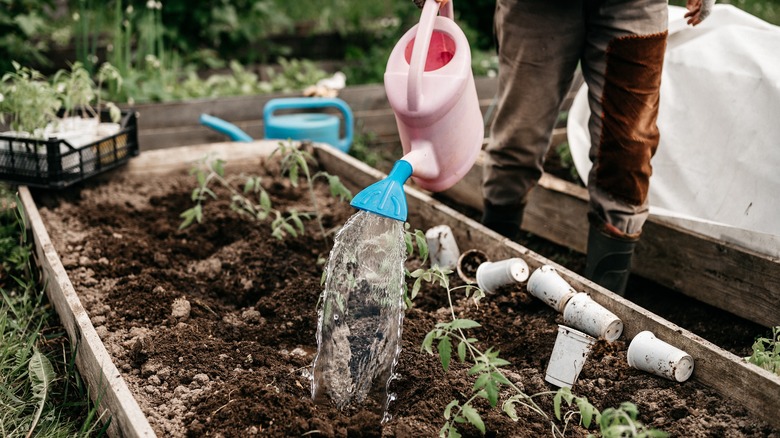The First Thing You Should Do To Your Plants After A Tropical Storm
Rain can be a gardener's best friend. It waters your plants for you, thus saving time and money. Even house plant enthusiasts pop their pots outside during an afternoon shower and take advantage of all that free water. Typically, as long as you've got well-draining soil, you can let the rain fall; the sun will evaporate excess water. However, intense weather systems are damaging. Tropical storms that bring heavy rainfall, wind, and hail can overwhelm your plants no matter how well you've prepared. That's why the first thing you need to do after a tropical storm is thoroughly inspect your plants for damage.
It is not uncommon for plants to become waterlogged from large amounts of rain. Pooling water that does not drain through the soil will instead cause root rot and create poor growing conditions. And, when storms form over the tropics, they carry copious amounts of salt water, which will inhibit photosynthesis. Tropical storms also bring heavy winds that can tear leaves, snap stems, and rip plants from the ground. Checking your pants and treating them post-storm is the best way to help them recover and prevent plant death.
Rinse away salt deposits on plant leaves
Tropical storms, hurricanes, and similar weather systems start over the ocean. Because of this, they carry a lot of salt water. That salty water then showers the land and leaves deposits called efflorescence. Salt build-up on plants usually occurs around the tip and edges of leaves. Salt deposits are a problem for any plant because of the sodium content. Sodium dehydrates plants even when they are first waterlogged. It's important to rinse your plants after a tropical storm to avoid damaging salt accumulation.
When treating your plants post-storm, it's best to rinse them with a hose. Use a gentle flow if you have a modifying attachment. Start from the top of the plant so the salt water moves downward as you rinse. Use a mixture of equal parts water, rubbing alcohol, and vinegar in a spray bottle to treat deposits on small or delicate plants. Without intervention, the sodium will cause a chemical reaction that will ultimately kill your plants.
Flush saturated soil to prevent root rot
When inspecting your plants, it's important to check the soil conditions around your ground plants. Heavy rainfall saturates soil and floods roots so they cannot absorb oxygen. If the soil is overly saturated, you'll need to act quickly because root rot needs only two days of standing water to grow. You need to dry the soil, but first, consider if your plants received large amounts of salt water. According to Nina Bassuk, professor of Urban Horticulture at Cornell University, "Salt water directly damages plants by accumulating chloride and sodium ions that can be toxic as they accumulate in plants. They can also create a kind of chemical drought where water in roots can diffuse out into the saltier soil." She suggests adding gypsum or lime to counteract the sodium.
It may seem counterintuitive to use water on waterlogged plants, but it's very important that you flush out the salt build-up. Cleansing the soil with an inch of water will clear out the salt water without adding to the problem. After you've flushed the soil, make small holes with a fork or trowel to assist with drainage. A layer of mulch or river rocks also aids in drying and will help prevent flooding during future storms.


